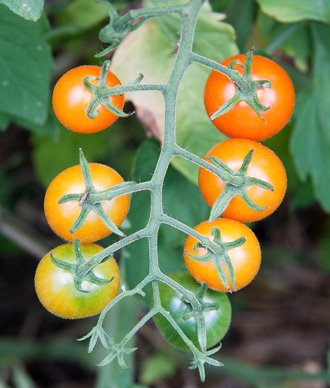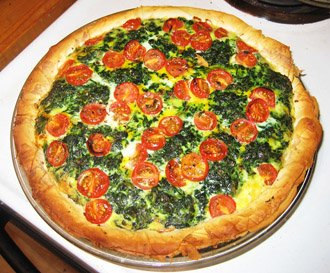Cherry Tomato Nutrition facts
Deliciously sweet, juicy cherry tomatoes are small, cherry-sized fruits with distinct bright colors and a pleasant flavor that distinguishes them from other tomato subtypes. These tiny berries are among the most sought-after for their vividly bright and attractive colors, whether cooked in dishes or raw in salads.
Botanically, cherry tomatoes belong to the same Solanaceae or nightshade family of plants, which also includes chili peppers, potatoes, and eggplants. They are believed to have originated in Central America from wild tomato cultivars.
Botanical name: Solanum lycopersicum L. var. Cerasiforme.
 |
| Cherry tomatoes. Courtesy: Tim Sackton |
Cherry tomatoes are warm-weather plants. While bush types are typically annuals, vine types (known as indeterminate or pole types) are perennial climbers unless hindered by lack of nutritional support or affected by high frost conditions at any stage of growth.
Clay and loam soils provide ideal conditions for abundant crops. For vine types, their long, climbing "indeterminate" stems require support from stakes for proper growth.
Fruits develop from flower ovaries, akin to berries, either bilocular or multilocular, with a diameter of around 2-3 cm. Numerous heirloom and hybrid varieties in various colors are cultivated for their sweet, "tomato-flavored" small, round to oval berries.
Harvesting is typically done by hand at maturity, which occurs approximately 80 to 110 days after planting. In vine-indeterminate types, harvesting can extend for 70 to 120 days or longer, with picking occurring 1-3 times per week.
Health Benefits of Cherry Tomato
Cherry tomatoes have the same amount of calories as regular, large tomatoes: 18 calories per 100g.
Despite being very low in calories and fat, they are excellent sources of antioxidants, dietary fiber, minerals, and vitamins.
Tomatoes, including cherries, along with olives and fish, form the basis of the health-benefiting Mediterranean diet.
Cherries are fine sources of antioxidants including lycopene, zeaxanthin, cryptoxanthin, and α and ß-carotenes.
Lycopene, a flavonoid antioxidant, is a unique phytochemical compound found in tomatoes. Red cherry tomatoes tend to possess more of this antioxidant. Together with carotenoids, lycopene may decrease the risk of certain cancers and heart disease, and also help to keep the immune system healthy through scavenging harmful oxygen-free radicals. Studies show that lycopene protects the skin from ultraviolet (UV) rays and thus offers some defense against skin cancer.
Zeaxanthin is another flavonoid compound present abundantly in cherry tomatoes. Zeaxanthin helps protect eyes from "age-related macular related macular disease" (ARMD) in older adults by filtering harmful ultraviolet rays.
Cherry tomatoes are excellent sources of vitamin-A; 100g provides 833 IU (28% daily recommended levels). Together with flavonoid antioxidants such as α and ß-carotenes, xanthins, and lutein, vitamin A plays a major role as an antioxidant, helping maintain healthy mucosa and skin. Consumption of natural food items rich in flavonoids has been found to help protect from lung and oral cavity cancers.
Furthermore, these tiny berries are a very good source of antioxidant vitamin-C (providing 21% of recommended daily levels per 100 g); consumption of foods rich in vitamin-C helps the body develop resistance against infectious agents and scavenge harmful free radicals.
Fresh cherry tomatoes are very rich in potassium. 100 g contains 237 mg of potassium and just 5 mg of sodium. Potassium is an important component of cell and body fluids that helps control heart rate and blood pressure caused by sodium.
Moreover, they comprise healthy levels of B-complex vitamins such as folates, thiamin, niacin, and riboflavin as well as some essential minerals like iron, calcium, manganese, and other trace elements. On account of their versatile health-giving qualities, nutrition scientists recommend them in cholesterol-controlling and weight-reduction diet programs.
| Principle | Nutrient Value | Percent of RDA |
|---|---|---|
| Energy | 18 Kcal | 1% |
| Carbohydrates | 3.9 g | 3% |
| Protein | 0.9 g | 1.6% |
| Total Fat | 0.2 g | 0.7% |
| Cholesterol | 0 mg | 0% |
| Dietary Fiber | 1.2 g | 3% |
| Vitamins | ||
| Folates | 15 μg | 4% |
| Niacin | 0.594 mg | 4% |
| Pyridoxine | 0.080 mg | 6% |
| Thiamin | 0.037 mg | 3% |
| Vitamin A | 833 IU | 28% |
| Vitamin C | 13 mg | 21.5% |
| Vitamin E | 0.54 mg | 4% |
| Vitamin K | 7.9 μg | 6.5% |
| Electrolytes | ||
| Sodium | 5 mg | >1% |
| Potassium | 237 mg | 5% |
| Minerals | ||
| Calcium | 10 mg | 1% |
| Iron | 0.3 mg | 4% |
| Magnesium | 11 mg | 3% |
| Manganese | 0.15 mg | 6.5% |
| Phosphorus | 24 mg | 3% |
| Zinc | 0.17 mg | 1.5% |
| Phyto-nutrients | ||
| Carotene-ß | 449 μg | -- |
| Carotene-α | 101 μg | -- |
| Lutein-zeaxanthin | 123 μg | -- |
| Lycopene | 2573 μg | -- |
Selection and Storage
Fresh cherry tomatoes are available year-round in supermarkets and grocery stores. When selecting them, opt for bright, intact tomatoes without cracks or wrinkles, which should feel firm but yield slightly to pressure. Avoid soft, spotted, or damaged ones.
At room temperature, fresh cherry tomatoes will keep well for 2-3 days when stored away from sunlight. Refrain from washing them until just before use. If not consumed immediately, store them in the fridge to extend their shelf life. For enhanced flavor and a richer taste, allow them to sit at room temperature for approximately 30 minutes before eating.
Preparation and Serving methods
Rinse the cherry tomatoes in cold water and pat them dry using a paper towel. Then, remove the caps.
To prepare them, take off the top calyx (caps). Unlike with larger tomato varieties, many people prefer using whole cherry tomatoes in dishes and salads. However, if you prefer them sliced, you can cut them into halves or cubes.
 |
| Quiche-cherry tomatoes, spinach and and goat cheese. Courtesy: Saraha & Jason |
Here are some serving tips:
Cherry tomatoes are generally preferred in salads and gentle stir-fries, especially in Mediterranean, Greek, and Italian cuisines.
Cherry tomatoes can be eaten raw or cooked. When raw, ripe cherries can be enjoyed out of hand, similar to table grapes.
Cherry tomatoes dressed with vinaigrette are relished in hors d'oeuvre (appetizers) and sandwiches.
They can make dishes look vibrant, and chefs always prefer to add them for special decorative effects.
They complement other vegetables well, such as brussel sprouts, olives, bell peppers, and eggplant.
They are also a perfect accompaniment to fish, beef, chicken, veal, or eggs.
Popular as pomodoro ciliegino, cherries are commonly featured in pizzas, quiches, tarts, and salads in Italian cuisine.
Safety Profile
Allergy or hypersensitivity reactions to cherry tomatoes are relatively rare, but they may occur in sensitive individuals, manifesting symptoms such as itching skin and eyes, a runny nose, and gastrointestinal disturbances like stomach pain, vomiting, and diarrhea. Medical Disclaimer- for more information.
Also read ≺≺-
≻≻- Why should I combine Avocados and Tomatoes?
≻≻-Tamarillo (Tree tomato) Nutrition facts and health benefits.
≻≻-Tomatillo (Tomate) Nutrition facts and health benefits.
≻≻-Tomato Nutrition facts and health benefits.
≻≻-Back to Vegetables from Cherry Tomatoes. Visit here for an impressive list of vegetables with complete illustrations of their nutrition facts and health benefits.
≻≻-Back to Home page.
Further reading:
Department of Horticulture- Purdue University Cooperative extension service. (Link opens in new window).